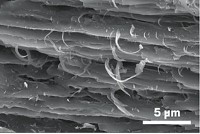Advertisement
Grab your lab coat. Let's get started
Welcome!
Welcome!
Create an account below to get 6 C&EN articles per month, receive newsletters and more - all free.
It seems this is your first time logging in online. Please enter the following information to continue.
As an ACS member you automatically get access to this site. All we need is few more details to create your reading experience.
Not you? Sign in with a different account.
Not you? Sign in with a different account.
ERROR 1
ERROR 1
ERROR 2
ERROR 2
ERROR 2
ERROR 2
ERROR 2
Password and Confirm password must match.
If you have an ACS member number, please enter it here so we can link this account to your membership. (optional)
ERROR 2
ACS values your privacy. By submitting your information, you are gaining access to C&EN and subscribing to our weekly newsletter. We use the information you provide to make your reading experience better, and we will never sell your data to third party members.
Biomaterials
Uncovering the secret of aggressive shrimp’s tough body armor
Study identifies structural features in mineralized cuticle that make the biocomposite resistant to fractures
by Mitch Jacoby
June 15, 2019
| A version of this story appeared in
Volume 97, Issue 24

If everyone you’re related to packs a powerful punch, you would be wise to avoid brawling with family members. The mantis shrimp, which sports a club-like appendage tough enough to crack clamshells, ought to follow that advice but doesn’t. These aggressive marine crustaceans, which grow to several centimeters in length, survive repeated body punches from relatives in tussles over territory thanks to highly effective belly armor. By combining microscopy and X-ray analyses with mechanical tests, researchers have determined how the protective organ known as a telson works so effectively (Adv. Funct. Mater. 2019, DOI: 10.1002/adfm.201902238). The findings may lead to new types of lightweight, impact-resistant materials for helmets, sports equipment, and other applications. A research group led by David Kisailus of the University of California, Riverside, compared the telsons of two types of mantis shrimp: more aggressive ones that smash their prey and less aggressive ones that spear their prey. Telsons of both species are composed of mineralized cuticle with exterior ridges and helical, layered internal structures—features that dissipate energy. But the smashers’ telsons are tougher. They are thicker (up to 700 μm versus 100 μm in the spearing type), exhibit a higher degree of mineralization (based on concentrations of calcium and phosphorus), and are more concave, making the smashers’ armor stiffer and better suited to resisting repeated high-energy impacts.





Join the conversation
Contact the reporter
Submit a Letter to the Editor for publication
Engage with us on Twitter